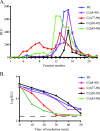Functional requirements of the yellow fever virus capsid protein
- PMID: 17526891
- PMCID: PMC1900127
- DOI: 10.1128/JVI.02120-06
Functional requirements of the yellow fever virus capsid protein
Erratum in
- J Virol. 2007 Dec;81(24):13944
Abstract
Although it is known that the flavivirus capsid protein is essential for genome packaging and formation of infectious particles, the minimal requirements of the dimeric capsid protein for virus assembly/disassembly have not been characterized. By use of a trans-packaging system that involved packaging a yellow fever virus (YFV) replicon into pseudo-infectious particles by supplying the YFV structural proteins using a Sindbis virus helper construct, the functional elements within the YFV capsid protein (YFC) were characterized. Various N- and C-terminal truncations, internal deletions, and point mutations of YFC were analyzed for their ability to package the YFV replicon. Consistent with previous reports on the tick-borne encephalitis virus capsid protein, YFC demonstrates remarkable functional flexibility. Nearly 40 residues of YFC could be removed from the N terminus while the ability to package replicon RNA was retained. Additionally, YFC containing a deletion of approximately 27 residues of the C terminus, including a complete deletion of C-terminal helix 4, was functional. Internal deletions encompassing the internal hydrophobic sequence in YFC were, in general, tolerated to a lesser extent. Site-directed mutagenesis of helix 4 residues predicted to be involved in intermonomeric interactions were also analyzed, and although single mutations did not affect packaging, a YFC with the double mutation of leucine 81 and valine 88 was nonfunctional. The effects of mutations in YFC on the viability of YFV infection were also analyzed, and these results were similar to those obtained using the replicon packaging system, thus underscoring the flexibility of YFC with respect to the requirements for its functioning.
Figures






Similar articles
-
Construction and applications of yellow fever virus replicons.Virology. 2005 Jan 20;331(2):247-59. doi: 10.1016/j.virol.2004.10.034. Virology. 2005. PMID: 15629769
-
Helices alpha2 and alpha3 of West Nile virus capsid protein are dispensable for assembly of infectious virions.J Virol. 2009 Jun;83(11):5581-91. doi: 10.1128/JVI.02653-08. Epub 2009 Mar 18. J Virol. 2009. PMID: 19297470 Free PMC article.
-
Capsid protein C of tick-borne encephalitis virus tolerates large internal deletions and is a favorable target for attenuation of virulence.J Virol. 2002 Apr;76(7):3534-43. doi: 10.1128/jvi.76.7.3534-3543.2002. J Virol. 2002. PMID: 11884577 Free PMC article.
-
High-Throughput Platform for Detection of Neutralizing Antibodies Using Flavivirus Reporter Replicon Particles.Viruses. 2022 Feb 8;14(2):346. doi: 10.3390/v14020346. Viruses. 2022. PMID: 35215941 Free PMC article.
-
Establishment and Application of Flavivirus Replicons.Adv Exp Med Biol. 2018;1062:165-173. doi: 10.1007/978-981-10-8727-1_12. Adv Exp Med Biol. 2018. PMID: 29845532 Review.
Cited by
-
Yellow Fever: Integrating Current Knowledge with Technological Innovations to Identify Strategies for Controlling a Re-Emerging Virus.Viruses. 2019 Oct 17;11(10):960. doi: 10.3390/v11100960. Viruses. 2019. PMID: 31627415 Free PMC article. Review.
-
Identification and characterization of key residues in Zika virus envelope protein for virus assembly and entry.Emerg Microbes Infect. 2022 Dec;11(1):1604-1620. doi: 10.1080/22221751.2022.2082888. Emerg Microbes Infect. 2022. PMID: 35612559 Free PMC article.
-
West Nile virus genome with glycosylated envelope protein and deletion of alpha helices 1, 2, and 4 in the capsid protein is noninfectious and efficiently secretes subviral particles.J Virol. 2013 Dec;87(23):13063-9. doi: 10.1128/JVI.01552-13. Epub 2013 Sep 18. J Virol. 2013. PMID: 24049184 Free PMC article.
-
Bovine viral diarrhea virus core is an intrinsically disordered protein that binds RNA.J Virol. 2008 Feb;82(3):1294-304. doi: 10.1128/JVI.01815-07. Epub 2007 Nov 21. J Virol. 2008. PMID: 18032507 Free PMC article.
-
Oral Delivery of a DNA Vaccine Expressing the PrM and E Genes: A Promising Vaccine Strategy against Flavivirus in Ducks.Sci Rep. 2018 Aug 17;8(1):12360. doi: 10.1038/s41598-018-30258-3. Sci Rep. 2018. PMID: 30120326 Free PMC article.
References
Publication types
MeSH terms
Substances
Grants and funding
LinkOut - more resources
Full Text Sources
Other Literature Sources

